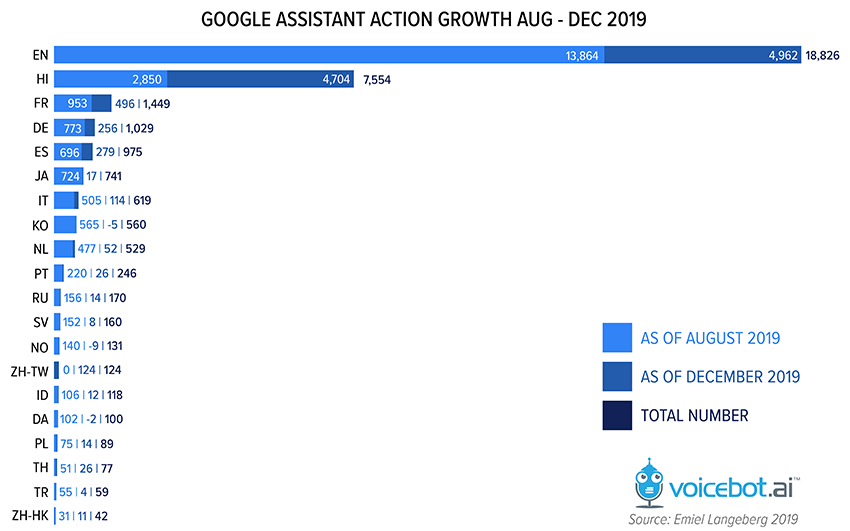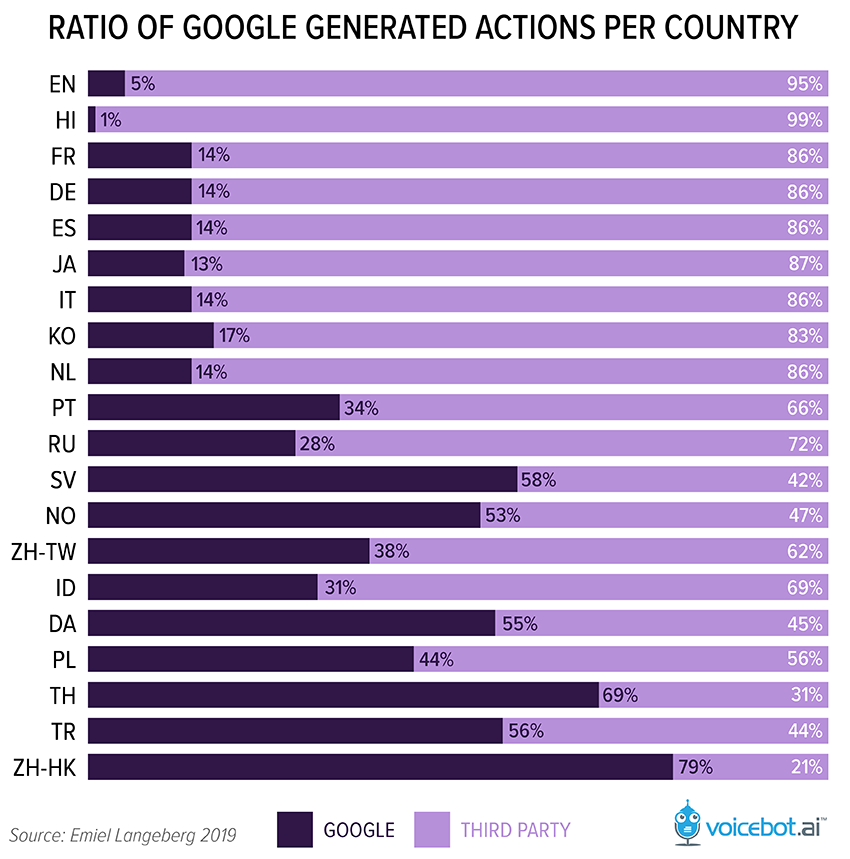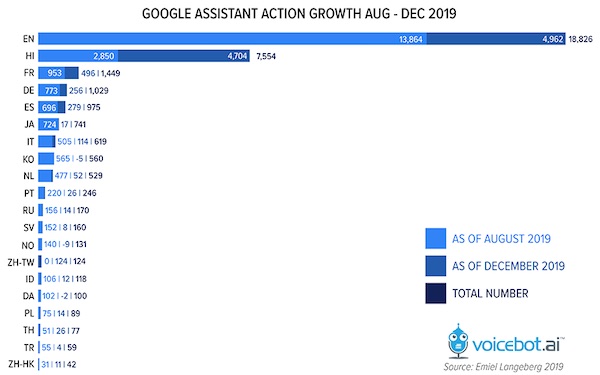Google Assistant Actions Grew Quickly in Several Languages in 2019, Matched Alexa Growth in English
- English-language Google Assistant Actions grew by over 340% in 2019 finishing the year at 18,826
- Hindi is the language with the second-highest Google Action count of 7,554
- In 2019, new Google Action launches in English were comparable to the number of new U.S. Alexa skills
- Google Assistant still trails Alexa in total voice apps in languages where they both compete, but Actions have stronger momentum than in the past
- Google Assistant Actions are available in 13 countries where Amazon has no Alexa alternative
Google Assistant Actions grew from just a few thousand in English at the end of 2018 to nearly nineteen thousand at the end of 2019. In fact, the total number of Google Actions in English rose 36% just between August and December 2019 according to data furnished to Voicebot.ai by Emiel Langeberg, voice designer, and researcher at Kandoor.nl. However, the bigger growth rate during that period was in Hindi. The total Google Action count in Hindi in August 2019 was just 2,850. That figure rose 165% to 7,554 by the end of December.

The Rise of Hindi on Google Assistant
This rapid growth in India is likely related to Google’s successful deployment of the Assistant on feature phones that use Kai OS. In an exclusive Voicebot interview in July 2018, Google’s Austin Chang commented:
“When we enabled [Google Assistant] on feature phones we saw usage explode. These are not proficient internet users. They are used to it just being a telephone. They are now using the devices to find information and entertainment on the internet. We are now seeing Google Assistant as the easiest way to access the internet.”
Google Assistant access through feature phones provides a far larger audience than smart speakers which are new to the country and have relatively small household penetration. This creates a different set of incentives for developers to support the Google Assistant ecosystem. Granted, there are still fewer Google Actions available in India than Alexa skills. The difference is that the Alexa skills reported by Voicebot research are English-language and not Hindi. India may be a country where Google has long-term advantages that will be hard for Amazon to replicate. It also appears that Google does have a Hindi-language advantage already in place today.
Comparing Google Actions to Alexa Skills
Google doesn’t report Action counts officially and displays the information in a way that makes it difficult to determine how many are in circulation. The company also categorizes Actions by language, unlike Amazon Alexa skills which are segmented by country. So, these differences don’t allow us to make too many direct comparisons, but we can offer a few insights.
Voicebot data combined with that provided by Langeberg suggest that the number of new English-language Google Actions launched per day in 2019 was nearly 40. That figure was up nearly six times from the 2018 figure of about 7 new Actions per day. Voicebot data suggest that new English-language Google Actions were launching at about the same rate per day as Alexa skills which averaged about 38 in 2019. It is tempting to say that Google Action launches in English exceeded the daily rate of Alexa skills, but that would be true only if we looked at skills in the U.S. When you consider English-language skills built for other countries outside of the U.S., it is likely the new Alexa skill rate is about the same or slightly higher. However, the figures suggest solid growth in developer activity around Google Assistant and the first time Action developers may be matching Alexa skill developers in the rate of new voice app launches.
Emiel Langeberg commented on this trend of Google Action growth by saying, “In 2018 there were on average seven new English Actions available every day. In 2019, the number has risen to almost 40 new English actions every day. In my book, that is significant growth.”
If we use U.S. Alexa skills as a proxy comparison for English-language Google Actions we also see that there are 3.6 times more Alexa skills but the gap didn’t grow in 2019 and may have narrowed slightly. Alexa also has a lead in French-language skills but it is even smaller at only about 45%. Germany, Spain, and Italy show Google Actions as well behind Alexa in skill counts despite the fact that Google launched in Spain and Italy well ahead of Alexa-enabled devices so the growth scorecard for the company is mixed.
The data show that Google still has some work to do in building out the Action developer community, but there appears to be some momentum. A bigger impact will likely be felt if Google can effectively activate its over six million Android developers and turn some of their development efforts to the Assistant. This is likely to be a strong theme at the Google I/O developer conference in 2020.
Google has another important advantage over Amazon in the global race for voice assistant adoption given that it supports languages in 13 countries where there is no Alexa option. Amazon is likely to focus in markets where it has an e-commerce presence whereas Google already has a global footprint in search and mobile and its plan to be everywhere means to be in just about every country.
Google First Party or Web Sourced Actions are Common
Voicebot has previously reported that Google is responsible for a large number of Actions in several markets. This can be seen clearly in Langeberg’s data. Google-generated Actions are either directly developed by Google or are sourced on the web using a Google crawler that simply makes the content available for use through Google Assistant. As a result, these Gooogle-generated Actions look like they were created by third-party developers, but they were not. We consider these either first-party or first-party sourced Actions and as a result, don’t relate to developer commitment to the platform.
The lowest percentage of Google-generated Actions by language is Hindi with 99% coming from third-parties. That is followed by English which has 95% of Actions generated by third-party developers in the Google Assistant ecosystem. On the opposite end of the ratio are Hong Kong and Thailand which have 79% and 69% Google-generated Actions respectively.

Google-generated Actions tend to be a higher percentage of the available voice apps in the languages with fewer Actions overall. This makes sense as Google is seeding the markets with content while the third-party developer ecosystem grows. However, it does lead to some surprises. Voicebot has spoken with large enterprises that are surprised to learn they have a Google Action listed in the Assistant directory only to learn it was not developed by their company but was auto-generated by Google. In these instances, the company can request Google remove it or replace it with a new Action developed by the business.
Follow @bretkinsella Follow @voicebotai
New Alexa Skill Data Show New U.S. Skills Launched in 2019 Fall to Lowest Level Since 2016









